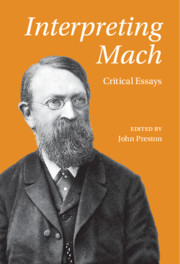Book contents
- Interpreting Mach
- Interpreting Mach
- Copyright page
- Dedication
- Contents
- Figures
- Tables
- Contributors
- Introduction
- 1 Ernst Mach’s Piano and the Making of a Psychophysical Imaginarium
- 2 Mother’s Milk and More
- 3 Meaningful Work
- 4 Mach on Analogy in Science
- 5 Ernst Mach’s Enlightenment Pragmatism
- 6 On the Philosophical and Scientific Relationship between Ernst Mach and William James
- 7 Ernst Mach and Friedrich Nietzsche
- 8 Abstraction, Pragmatism, and History in Mach’s Economy of Science
- 9 Holding the Hand of History
- 10 Ernst Mach and the Vienna Circle
- 11 Narratives Divided
- 12 Phenomenalism, or Neutral Monism, in Mach’s Analysis of Sensations?
- 13 The Case for Mach’s Neutral Monism
- Index
- References
1 - Ernst Mach’s Piano and the Making of a Psychophysical Imaginarium
Published online by Cambridge University Press: 05 March 2021
- Interpreting Mach
- Interpreting Mach
- Copyright page
- Dedication
- Contents
- Figures
- Tables
- Contributors
- Introduction
- 1 Ernst Mach’s Piano and the Making of a Psychophysical Imaginarium
- 2 Mother’s Milk and More
- 3 Meaningful Work
- 4 Mach on Analogy in Science
- 5 Ernst Mach’s Enlightenment Pragmatism
- 6 On the Philosophical and Scientific Relationship between Ernst Mach and William James
- 7 Ernst Mach and Friedrich Nietzsche
- 8 Abstraction, Pragmatism, and History in Mach’s Economy of Science
- 9 Holding the Hand of History
- 10 Ernst Mach and the Vienna Circle
- 11 Narratives Divided
- 12 Phenomenalism, or Neutral Monism, in Mach’s Analysis of Sensations?
- 13 The Case for Mach’s Neutral Monism
- Index
- References
Summary
Psychophysics as Mach understood it could be explained in several ways. This reflects the central conundrum that psychophysics held the potential to resolve: the communication of an individual’s subjective experience. This chapter surveys the many ways in which Mach described psychophysical experiences, from demonstrations on his Bösendorfer grand piano to differential equations. These descriptions were often multi-modal, using sound and images in tandem. Mach also employed analogies, mathematical derivations, and descriptions of the subjective experience of such phenomena as accommodation, acceleration, and visual after-images. A comparison of how Mach discusses psychophysics in popular lectures, scientific publications, and personal correspondence suggests that he made a number of assumptions about how best to communicate scientific ideas to different audiences. Further, this chapter argues that Mach’s techniques of presentation/argumentation, celebrated both in his time and subsequently, went far towards cultivating a psychophysical imaginarium similar to a mind’s eye. That is, by asking his readers or listeners to imagine specific psychophysical experiences, Mach established the broad outlines of a new way of thinking about subjectivity.
- Type
- Chapter
- Information
- Interpreting MachCritical Essays, pp. 10 - 27Publisher: Cambridge University PressPrint publication year: 2021
References
- 3
- Cited by



